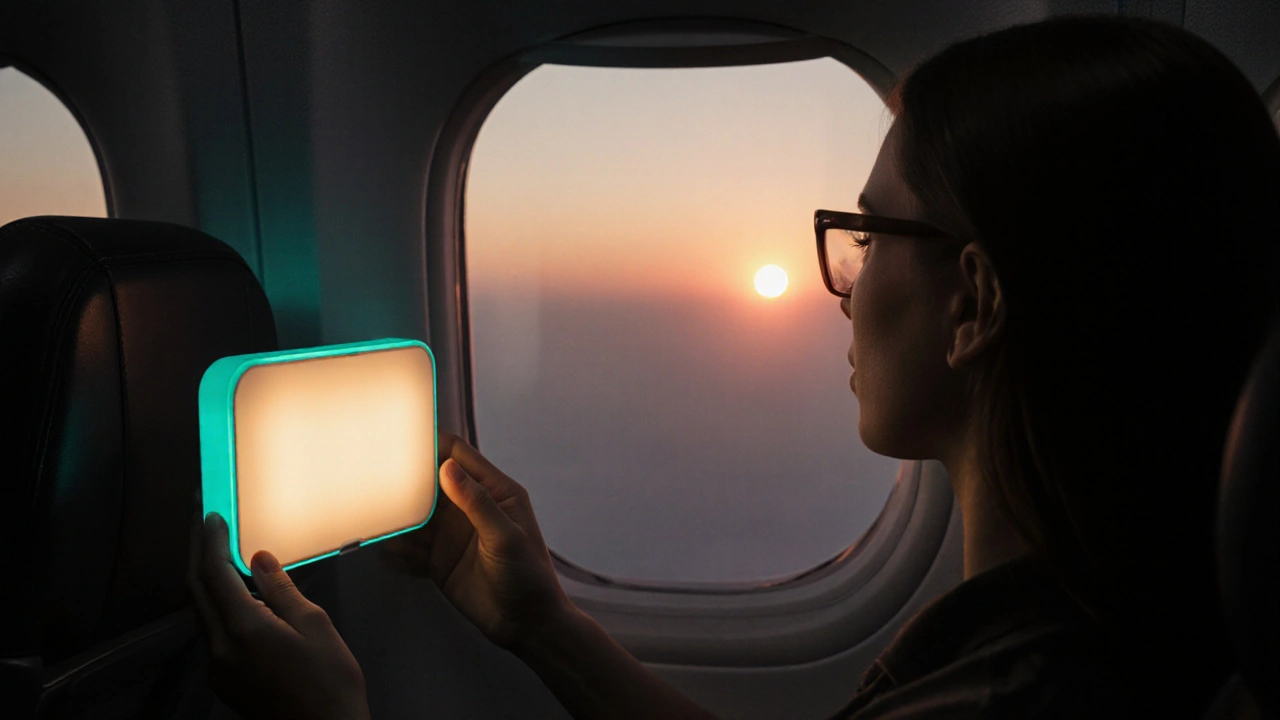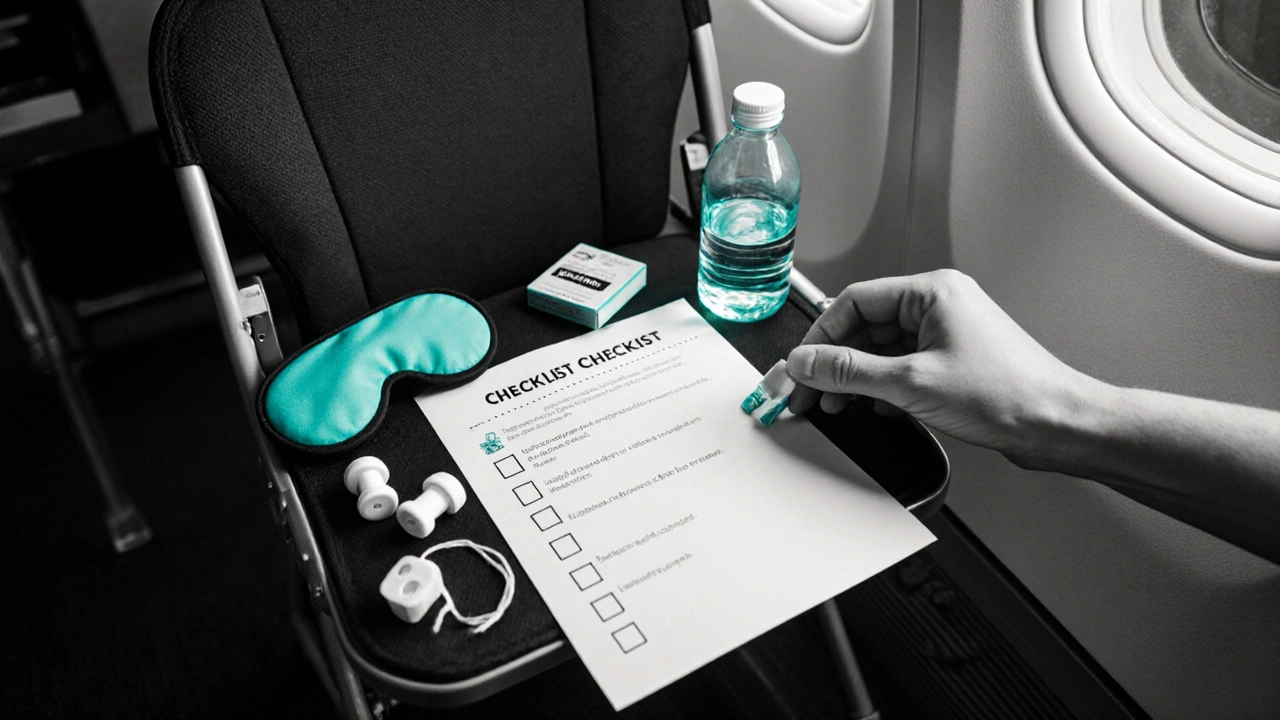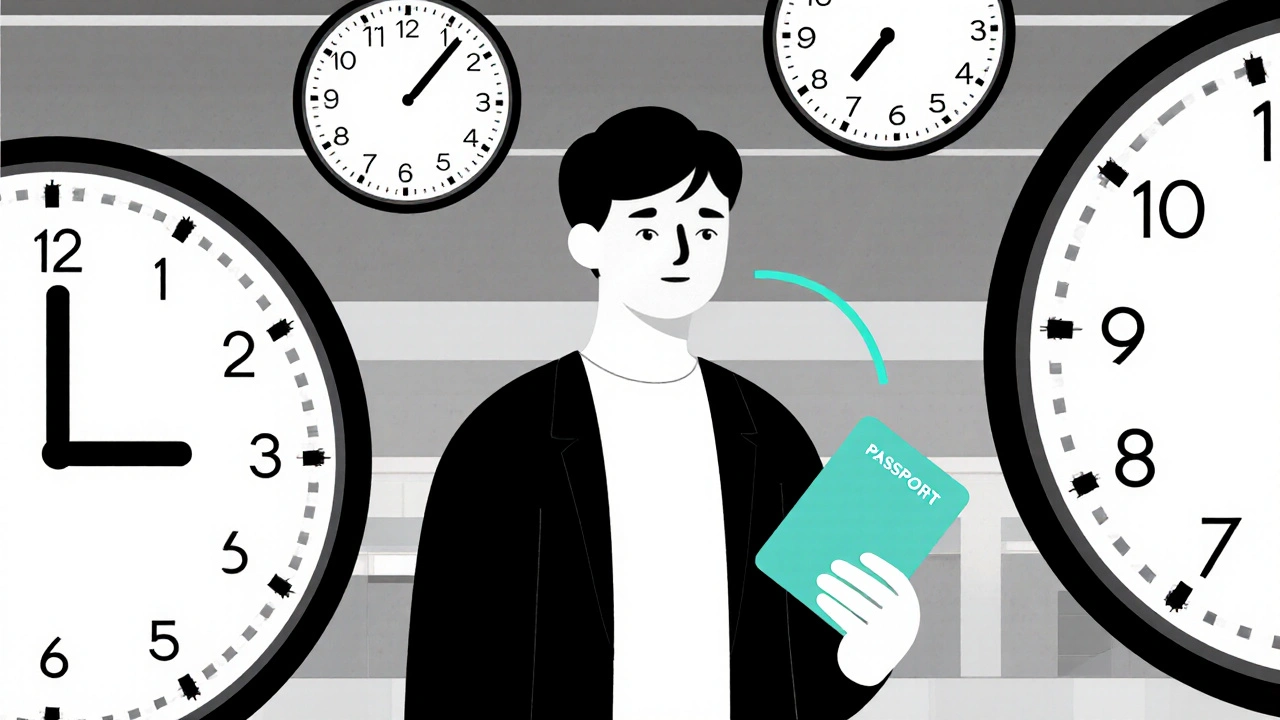Jet Lag Adjustment Calculator
Enter Travel Details
How It Works
This calculator generates a personalized 3-5 day adjustment schedule based on your travel details. Eastward travel typically requires advancing your schedule, while westward travel needs delaying it.
Estimated Adjustment Period:
Your Personalized Adjustment Schedule
Travel Direction:
Time Zones Crossed:
Estimated Adjustment Period:
| Day | Morning | Afternoon | Evening |
|---|
Cross‑continent flights can feel like a sprint for your brain, especially when the clock flips and you’re stuck fighting a wave of jet lag. The good news? You don’t have to surrender to endless yawning. By understanding how your internal clock reacts to new time zones and applying a handful of practical tricks, you can shrink the adjustment period from days to hours.
What Is Jet Lag and Why Does It Make You Sleepy?
At its core, Jet lag is a temporary misalignment between your body’s internal circadian rhythm and the local day‑night cycle after rapid travel across multiple time zones. Your brain’s master clock, located in the suprachiasmatic nucleus, keeps a steady 24‑hour beat. When you hop from London to Tokyo, that beat is suddenly out of sync with sunrise, meals, and work schedules, triggering a cascade of symptoms: grogginess, impaired concentration, digestive upset, and that relentless urge to nap at the wrong moments.
How Your Circadian Rhythm Controls Sleepiness
The Circadian rhythm is the natural, internal process that regulates the sleep‑wake cycle and repeats roughly every 24 hours is driven by two main cues: light and melatonin. Exposure to bright light suppresses melatonin, keeping you alert, while darkness triggers its release, signaling your body to wind down. When you cross time zones, the light‑dark pattern you’ve been accustomed to no longer matches the external environment, so melatonin spikes at inconvenient times, leaving you drowsy when you need to stay sharp.
Pre‑Travel Planning: Set the Clock Before You Leave
Adjusting your schedule a few days before departure can shave off up to half the typical jet‑lag fatigue. Here’s a quick roadmap:
- Shift bedtime and wake‑time by 30-60 minutes toward your destination’s schedule. Do this gradually for three days leading up to the flight.
- Sync meals with the new local time. Your digestive system is a secondary clock that follows eating patterns.
- Limit caffeine after noon in your home time zone to avoid lingering alertness once you arrive.
These small changes prime your Chronotype the natural tendency toward being a morning or evening person to adapt more fluidly.
Light Exposure Strategies: Your Fastest Reset Tool
Light is the most powerful cue you can harness. The goal is to get bright light when you need to stay awake and avoid it when you want to sleep.
- Morning sunlight (or a 10,000‑lux light box) for 20-30 minutes if you need to advance your clock (eastward travel).
- Afternoon/evening light if you need to delay your clock (westward travel). Stay outdoors after local noon.
- Wear Blue‑light‑blocking glasses eyewear that filters short‑wavelength light to reduce melatonin suppression after sunset.
When you’re on a long‑haul flight, position yourself near a window and open the shade at the appropriate local times. Even a few minutes of daylight can tip the hormonal balance.

Melatonin Supplements: When and How to Use Them
Melatonin is a hormone your brain releases in darkness. A low‑dose supplement can cue your body that it’s night time, but timing is critical.
- Take 0.5-3mg of melatonin 30‑60 minutes before the target bedtime in the new time zone.
- Limit use to the first three nights to avoid dependence.
- Consult a doctor if you’re pregnant, nursing, or on blood‑thinning medication.
Studies from 2023‑2024 show that melatonin combined with controlled light exposure cuts sleep latency by up to 40% compared with light alone.
Lifestyle Tweaks on the Plane and After Arrival
Flying itself can compound sleepiness: low cabin pressure, dry air, and cramped seating all disturb sleep architecture.
- Stay hydrated: Aim for at least 2L of water; avoid alcohol and excessive coffee.
- Move every hour: Simple stretches or a quick walk down the aisle keep circulation flowing and reduce fatigue.
- Power‑nap wisely: If you must nap, limit it to 20‑30 minutes and set an alarm aligned with your destination’s night.
- Maintain a sleep‑friendly environment: Use an eye mask, ear plugs, and a neck pillow to simulate darkness and quiet.
Once on the ground, stick to the local schedule for meals, exercise, and social activities. Even a brief walk in the afternoon sun can re‑set your internal clock.
Sample 5‑Day Adjustment Schedule
| Day | Morning | Afternoon | Evening |
|---|---|---|---|
| Day1 | 30min sunrise exposure, light breakfast at 07:00 | Stay active, avoid caffeine after 12:00 | Melatonin 0.5mg at 19:30, dim lights |
| Day2 | Light box 20min, shift wake‑up to 06:30 | Short walk, light lunch | Melatonin 1mg at 19:00, no screens after 20:00 |
| Day3 | Outdoor jog 25min, breakfast 06:00 | Maintain hydration, avoid alcohol | Melatonin 2mg at 18:45, bedtime 22:30 |
| Day4 | Sunrise exposure, wake at 05:45 | Normal work schedule, caffeine only before 10:00 | Skip melatonin, follow dark‑room routine |
| Day5 | Full daylight, regular breakfast | Exercise later in day | Consistent bedtime 22:00, no supplements |
This plan assumes a 6‑hour eastward shift (e.g., London → New York). For westward travel, flip the light exposure timing: seek evening light and delay melatonin.

Common Mistakes That Prolong Jet Lag
Even with a solid plan, a few habits can sabotage your recovery:
- Sleeping through the first night in the new location - it resets the clock to the old time zone.
- Over‑relying on caffeine - it can delay melatonin release and worsen night‑time alertness.
- Skipping meals - irregular eating confuses the secondary digestive clock.
- Ignoring light cues - staying indoors after arrival stalls adjustment.
Spotting these pitfalls early helps you course‑correct before fatigue takes over.
Quick Checklist for a Smooth Transition
- Shift sleep times 30min toward destination for 3days pre‑flight.
- Pack a light box, blue‑blocking glasses, eye mask, and ear plugs.
- Hydrate - 2L water, limit alcohol (<1unit) and coffee after noon.
- Plan sunrise/sunset exposure based on travel direction.
- Take 0.5-3mg melatonin only the first 2‑3 nights.
- Stick to local meal times; keep snacks light and protein‑rich.
- Schedule a brief walk or stretch every 60minutes on the plane.
Frequently Asked Questions
Can I completely avoid jet lag?
You can dramatically reduce symptoms by using light, melatonin, and sleep‑time shifts, but a small amount of fatigue is normal after a major time‑zone jump. The goal is to feel functional within 24‑48hours, not to be perfectly rested instantly.
Is melatonin safe for frequent travelers?
Short‑term use (up to five nights) at low doses is regarded as safe for most adults. People with hormonal disorders, pregnant or nursing women, and those on certain medications should check with a physician first.
How long does it take to fully adjust after crossing the International Date Line?
A rough rule is one day per time‑zone hour, but with strategic light exposure you can cut that in half. Most travelers report feeling normal after 2-3 days for a 12‑hour shift.
Should I nap on the plane?
If the flight coincides with your destination’s night, a short 20‑minute power nap can help. Longer naps can push your internal clock further out of sync, so set an alarm.
What role does caffeine play in jet‑lag recovery?
Caffeine is useful for a quick alertness boost, but use it only in the first half of the local day. Too much after noon delays melatonin and can worsen nighttime sleep.







Sara Werb
October 16, 2025 AT 20:07Yo, fellow travelers!! This jet lag shiz is a TOTAL WAR on our American pride!!! You gotta pre‑shift your snoozetime like a soldier marchin to the beat of the US flag!! Grab that light box, chug water, and DON'T let some foreign time zone mess with your g‑force!!
Winston Bar
October 27, 2025 AT 19:07Honestly, this whole “light‑box miracle” thing is just hype and a waste of time.
Russell Abelido
November 7, 2025 AT 19:07I totally get how disorienting those first few hours can feel when you land in a brand‑new timezone. Your body’s internal clock is like an old friend who suddenly shows up late to the party, demanding attention. When the sun rises at the wrong hour, it’s as if the universe is whispering a baffling riddle that you have to solve before you can sleep peacefully. One of the most compassionate things you can do for yourself is to treat that riddle with patience, not frustration. Light exposure, as the post mentions, is the most powerful cue, and stepping outside for a brisk walk can feel like a gentle hug from daylight itself. I’ve tried the 10,000‑lux light box at the airport and felt the fog lift from my mind within minutes, like a fog‑horn clearing the harbor. On the other hand, slipping into a dark hotel room too early can trick your melatonin into thinking the night has already begun, leaving you groggy at noon. That’s why timing the melatonin supplement becomes a subtle art, like seasoning a stew just before it simmers. Keep the dose low – 0.5 to 1 mg – and take it half an hour before your intended bedtime, and you’ll notice a smoother transition. Hydration is another silent hero; the cabin air dries you out, and each sip of water is a tiny reminder that your body is still alive and adaptable. Moving every hour, even just stretching in the aisle, keeps circulation alive and discourages that heavy‑limb fatigue that many call “jet‑lag sluggishness.” And don’t forget meals – eating at the local schedule tells your digestive clock, “Hey, we’re here now!” which reinforces the new rhythm. If you can combine all these tricks, you’ll often feel like you’ve shaved days off the adjustment period, turning a week‑long slog into a couple of evenings. The science behind it is solid, but the real magic lies in listening to your own body’s signals and honoring them. So pack that eye mask, bring those blue‑blocking glasses, and greet the sunrise with a smile – you’ve got this! 🙂
Steve Holmes
November 18, 2025 AT 19:07Wow, that was a fantastic rundown!!! Any tips on how to balance the light exposure when you’re stuck on a red‑eye flight that doesn’t have a window?? Also, do you think a short nap of exactly 20 minutes is optimal, or should we tweak it based on personal rhythm???
genevieve gaudet
November 29, 2025 AT 19:07i think jet lag kinda mirrors life’s own misalignments – we plan, travel, and sometimes end up out of sync with the world around us. embracing the shift, instead of fighting it, can turn a stressful arrival into a moment of reflection. it’s like dancing to a new beat, even if the steps feel awkward at first.
Patricia Echegaray
December 10, 2025 AT 19:07What they don’t tell you is that the airlines purposefully dim the cabin lights to keep us in a perpetual state of confusion – a covert method to make us dependent on their “sleep aids” sold at the duty‑free shop!! It’s a grand design to control our circadian rhythm and push more profit, folks. Stay woke, stay bright!
Miriam Rahel
December 21, 2025 AT 19:07While the recommendations presented are largely accurate, the omission of recent chrono‑biology research regarding timed meals is a notable oversight. Moreover, the suggested melatonin dosages lack citation of the latest 2024 meta‑analysis, which recommends a ceiling of 0.3 mg for optimal phase shifting. In summary, the guide could benefit from a more rigorous scholarly foundation.